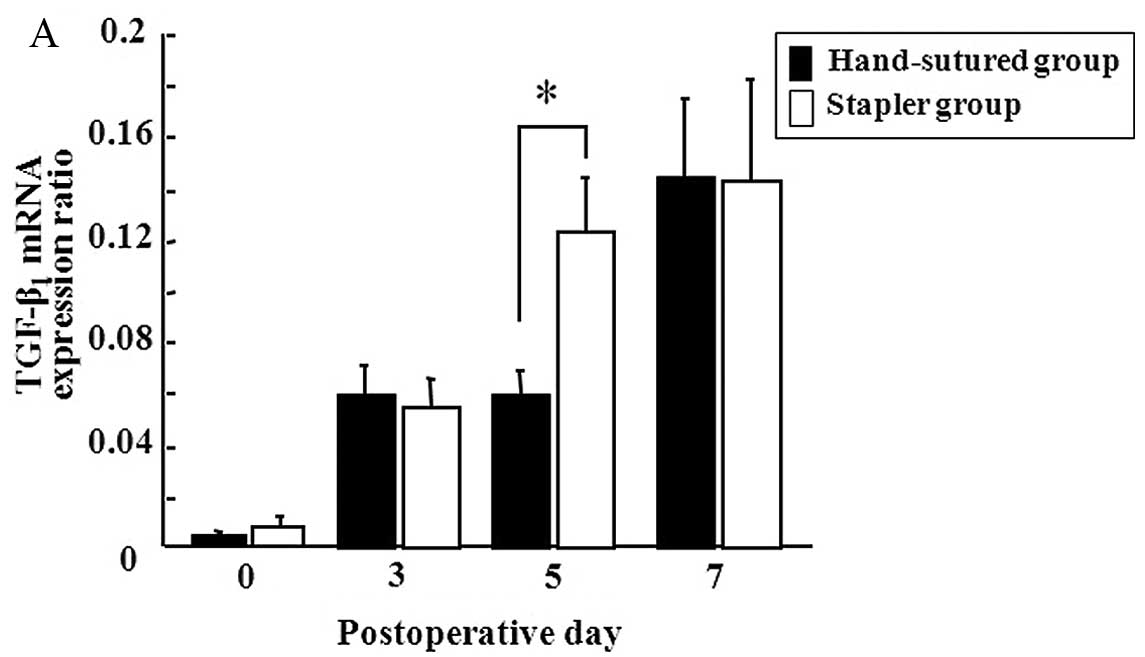|
1.
|
Guenaga KF, Matos D, Castro AA, Atallah AN
and Willejorgensen P: Mechanical bowel preparation for elective
colorectal surgery. Cochrane Databese Syst Rev. 2:CD0015442003.
|
|
2.
|
Peeters KC, Tollenaar RA, Marijnen CA, et
al: Risk factors for anastomotic failure after total mesorectal
excision of rectal cancer. Br J Surg. 92:211–216. 2005. View Article : Google Scholar
|
|
3.
|
Everett WG, Friend PJ and Forty J:
Comparison of stapling and hand suture for left sided large bowel
anastomosis. Br J Surg. 73:345–348. 1986. View Article : Google Scholar : PubMed/NCBI
|
|
4.
|
Kataoka M, Masaoka A, Hayashi S, et al:
Problems associated with the EEA stapling technique for
esophagojejunostomy after total gastrectomy. Ann Surg. 209:99–104.
1989. View Article : Google Scholar : PubMed/NCBI
|
|
5.
|
West of Scotland and Highland Anastomosis
Study Group: Suturing or stapling in gastrointestinal surgery: a
prospective randomized study. Br J Surg. 78:337–341. 1991.
View Article : Google Scholar : PubMed/NCBI
|
|
6.
|
Brennan SS, Pickford IR, Evans M and
Pollok AV: Staplers or sutures for colonic anastomoses - a
controlled clinical trial. Br J Surg. 69:722–724. 1982. View Article : Google Scholar : PubMed/NCBI
|
|
7.
|
Didolkar MS, Reed WP, Elias EG, Schnaper
LA, Brown SD and Chaudhary SM: A prospective randomized study of
sutured versus stapled bowel anastomoses in patients with cancer.
Cancer. 57:456–460. 1986. View Article : Google Scholar : PubMed/NCBI
|
|
8.
|
Fielding LP, Stewart-Brown S, Blesovsky L
and Kearny G: Anastomotic integrity after operations for
large-bowel cancer: a multicentre study. Br Med J. 281:411–414.
1980. View Article : Google Scholar : PubMed/NCBI
|
|
9.
|
Buckmire MA, Parquet G, Greenway S and
Rolandelli RH: Temporal expression of TGF-beta1, EGF, and PDGF-BB
in a model of colonic wound healing. J Surg Res. 80:52–57. 1998.
View Article : Google Scholar : PubMed/NCBI
|
|
10.
|
Cromack DT, Sporn MB, Roberts AB, Merino
MJ, Dart LL and Norton JA: Transforming growth factor beta levels
in rat wound chambers. J Surg Res. 42:622–628. 1987. View Article : Google Scholar : PubMed/NCBI
|
|
11.
|
Bauer SM, Bauer RJ, Liu ZJ, Chen H,
Goldstein L and Velazquez OC: Vascular endothelial growth factor-C
promotes vasculogenesis, angiogenesis, and collagen constriction in
three-dimensional collagen gels. J Vasc Surg. 41:699–707. 2005.
View Article : Google Scholar
|
|
12.
|
Wichterman KA, Baue AE and Chaudry IH:
Sepsis and septic shock a review of laboratory models and a
proposal. J Surg Res. 28:189–201. 1980. View Article : Google Scholar : PubMed/NCBI
|
|
13.
|
Ninomiya S, Inomata M, Tajima M, et al:
Effect of Bevacizumab, a humanized monoclonal antibody to vascular
endothelial growth factor, on peritoneal metastasis of MKN-45P
human gastric cancer in mice. J Surg Res. 154:196–202. 2009.
View Article : Google Scholar : PubMed/NCBI
|
|
14.
|
Stegemann H and Stalder K: Determination
of hydroxyproline. Clin Chim Acta. 18:267–273. 1967. View Article : Google Scholar
|
|
15.
|
Blasken P, Renvall S and Sandberg M:
Fibronectin and collagen gene expression in healing experimental
colonic anastomoses. Br J Surg. 78:1048–1052. 1991. View Article : Google Scholar : PubMed/NCBI
|
|
16.
|
Fukuchi SG, Seeburger JL, Parquet G and
Rolandelli RH: Influence of 5-fluorouracil on colonic healing and
expression of transforming growth factor-beta 1. J Surg Res.
84:121–126. 1999. View Article : Google Scholar : PubMed/NCBI
|
|
17.
|
Sarah KT, Eugene YC and Blair AJ: Clinical
review: healing in gastrointestinal anastomosis, part 1.
Microsurgery. 26:131–136. 2006. View Article : Google Scholar
|
|
18.
|
Ahrendt GM, Gardiner K and Barbul A: Loss
of colonic structural collagen impairs healing during
intra-abdominal sepsis. Arch Surg. 129:1179–1183. 1994. View Article : Google Scholar : PubMed/NCBI
|
|
19.
|
Barnard JA, Warwick GJ and Gold LI:
Localization of transforming growth factor beta isoforms in the
normal murine small intestine and colon. Gastroenterology.
105:67–73. 1993.PubMed/NCBI
|
|
20.
|
di Mola FF, Friess H, Scheuren A, et al:
Transforming growth factor-betas and their signaling receptors are
coexpressed in Crohn's disease. Ann Surg. 229:67–75.
1999.PubMed/NCBI
|
|
21.
|
Migaly J, Lieberman J, Long W, et al:
Effect of adenoviral-mediated transfer of transforming growth
factor-β1 on colonic anastomotic healing. Dis Colon Rectum.
47:1699–1705. 2004.
|
|
22.
|
Seifert WF, Verhofstad AAJ, Wobbes T, et
al: Quantitation of angiogenesis in healing anastomoses of rat
colon. Exp Mol Pathol. 64:31–40. 1997. View Article : Google Scholar : PubMed/NCBI
|
|
23.
|
Kleespies A, Guba M, Jauch K and Burns CJ:
Vascular endothelial growth factor in esophageal cancer. J Surg
Oncol. 87:95–104. 2004. View Article : Google Scholar : PubMed/NCBI
|
|
24.
|
Henry TD: Therapeutic angiogenesis. BMJ.
318:1536–1539. 1999. View Article : Google Scholar : PubMed/NCBI
|
|
25.
|
Christensen H, Chemnitz J, Christensen B
and Oxlund H: Collagen structural organization of healing colonic
anastomoses and the effect of growth hormone treatment. Dis Colon
Rectum. 38:1200–1205. 1995. View Article : Google Scholar : PubMed/NCBI
|
|
26.
|
Korolija D: The current evidence on
stapled versus hand-sewn anastomosis in the digestive tract. Minim
Invasive Ther Allied Technol. 17:151–154. 2008. View Article : Google Scholar : PubMed/NCBI
|
|
27.
|
Catena F, La Donna M, Gagliardi A, et al:
Stapled versus hand-sewn anastomosis in emergency intestinal
surgery: Results of a prospective randomized study. Surg Today.
34:123–126. 2004. View Article : Google Scholar : PubMed/NCBI
|












